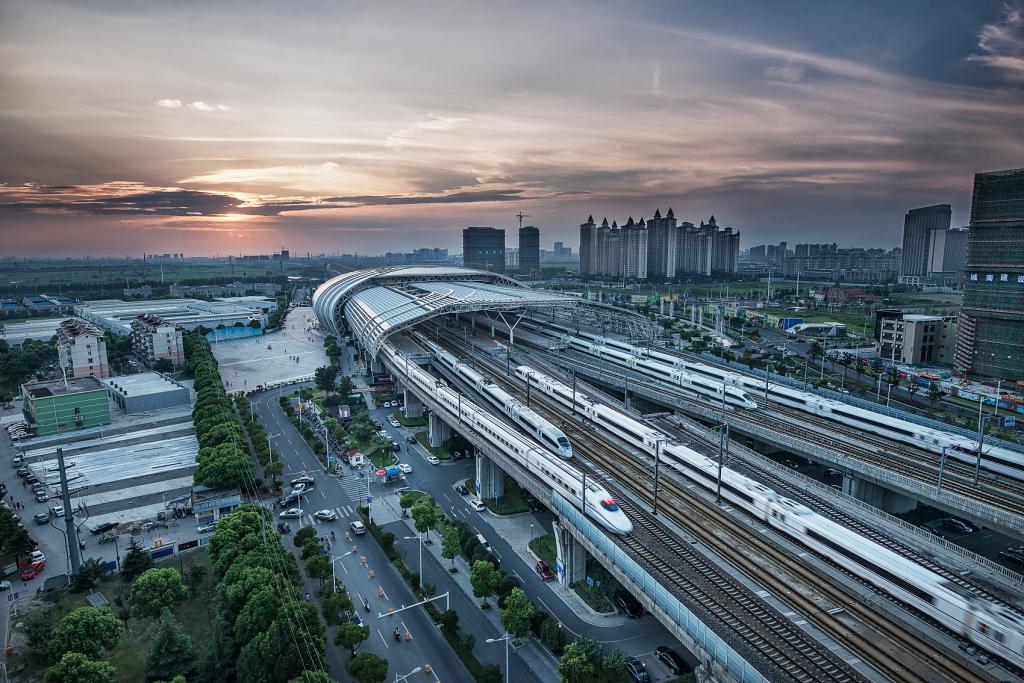SECTIONS Guanghua Insights
A blueprint for China’s development through the year 2035 unveiled on Oct. 29 after a plenary session of the 19th Communist Party of China (CPC) Central Committee has underscored the roles of innovation, a strong domestic market, rural vitalization, among others.
Meanwhile, more than 40 professors with Peking University’s Guanghua School of Management are participating in a major state-level research project that aims to provide detailed references and analysis for the formulating of the country’s 14th Five-Year Plan (2021-2025) and long-range objectives through 2035 as well as efforts to make China a strong modern country by 2050.
Liu Qiao, Dean of Guanghua, offers his insight into the signals from the just-concluded high-profile meeting and the country’s development plan for the coming years.

KEEP UP WITH THE TIMES
A unique staple of China’s development, a five-year plan is the epitome of an accomplished government plus an effective market as well as the combination of top-level design and grassroots vitality. It is the code that unlocks China’s rapid economic growth over the past 40 years.
China’s first five-year plan dates back to 1953. The drafting of one usually starts during the middle of the previous five-year period and lasts two or three years, encompassing the planning of major national projects and goals for social and economic development. Using a five-year plan to guide the country’s economic expectations and development path and stimulate grassroots vitality remains an unchanged practice for the Chinese leadership.
While this year sees China wrap up efforts to “build a moderately prosperous society in all respects,” 2021 marks the start of the country's march towards modernization. Against the background of profound changes, volatility and uncertainties across the world, last month’s plenary session of the CPC Central Committee was of special significance in actively charting the course for the country’s future based on meticulous analysis of complex exterior environments and deep understanding of China’s current development phase.
In the meantime, the core logic of China’s economy has changed. After more than four decades, factors that used to drive the country’s rapid development are becoming weak, and it must switch from speed- and scale-oriented development to high quality growth. Anti-globalization, the China-U.S. trade disputes and the Covid-19 pandemic have posed fresh challenges to China’s development for the next five years.
One medium- and long-term challenge is how to further boost China’s total factor productivity (TFP) after industrialization. The service sector will take up over 65 percent of the country’s GDP by 2035, and it is more difficult to maintain TFP growth in a service-led age than during industrialization.
Another is how to make China’s economy go higher in the global value chain and achieve a closed-loop supply chain, considering that China, despite its big role in the global value chain, relies on a huge amount of import from upstream.
The third challenge is the poor circulation of various factors such as capital, human resources and land, which is incompatible with the Chinese economy’s quality development.
As for opportunities, China, as the world’s second largest economy, boasts 400 million residents with medium-level incomes that are shoring up the country to become the world’s largest consumption market. Meanwhile, manufacturing takes up 27-28 percent of China’s GDP (compared to the 11 percent in the U.S.), which means that China’s own manufacturing industry is able to unleash huge potential for TFP growth if it is maintained at around 20 percent of GDP. Also, digital transformation is generating many opportunities for traditional industries, which, along with new infrastructure construction, will also create ample space for TFP growth. To top it off, industrial structure upgrade and population flow will see China’s urbanization rate increase from the current 60 percent to 75 to 80 percent in 2035. In other words, an additional 20 percent of China’s population will go from rural areas to cities in the coming 15 years, generating huge demand.
In order to address these challenges and seize the opportunities, the 14th five-year plan must be drafted with a different mindset, focusing on quality development, industrial structure balance, people’s livelihoods and innovation as the fuel for growth.
China’s development has never been fixated on a single formula. It is a process of theoretical and practical exploration constantly changing with time. In this sense, the 14th five-year plan is different because the current stage of China’s development is unique, and it paves the way for the plans for the next several five-year periods.

INNOVATION-DRIVEN
According to the communique released after the session, placed at the top of the development priorities is ensuring the core role of innovation in the modernization drive, and an independent and competent science and technology (S&T) sector will offer strategic support for the country’s development.
“Core” is a word of magnitude used very discreetly in Party documents, and unprecedented emphasis has been put on innovation in this communique. It is the country’s response to how to build a closed-loop supply chain. Key technologies that are important for economic development such as chips and plane engines have become crucial obstacles amid the China-U.S. trade disputes, and they are part of the issues that the 14th five-year plan needs to address.
Adopting an index measuring a country’s position in the global value chains, Guanghua’s research team estimates that China scored 0.01 in 2018 (higher figure indicates higher upstreamness). In comparison, U.S. scored 0.29 and the average of major economics of developed countries is 0.04. It means that China is relatively in the middle and downstream section of the global value chains and is more reliant on upstream supply of raw materials, core technologies and components.
To solve this issue, the communique urges efforts to enhance national strategic science and technology prowess, boost firms’ technical innovation capacities, unleash the vitality of innovative talents and improve the mechanism for S&T innovation. Higher research and development (R&D) capacity is a must. China put 2.2 percent of its GDP in R&D last year, about the average level of developed countries. However, in terms of research, its input in basic research amounted to only 5.5 to 6 percent of the total, far below the 18 percent in the U.S. and 25 percent in France. In other words, a lion’s share of the country’s funds are spent on development, with an inadequate focus on basic science and underlying technologies. The core and underlying technologies that China most lacks require long-term investment, but the country only started to enhance R&D efforts some 20 years ago. It begs the question: how should China invest in R&D in the coming years?

DOMESTIC CIRCULATION
The communique emphases domestic circulation when discussing the country’s “double circulation” strategy, urging efforts to nurture a strong domestic market and establish a new development pattern where domestic and foreign markets can boost each other, with the domestic market as the mainstay. Consumption and investment must be boosted.
In order to ensure smooth and efficient domestic circulation, China must first deepen the reform of factor markets. It is the country’s paradox that more funds go to firms and projects with lower returns rather than those with higher returns and better market vitality. The circulation of funds will not improve unless China solves this problem and ensures effective fund allocation.
In terms of human resources, China needs to better handle the issue of migrant workers living in cities as the country’s labor forces are decreasing. Guanghua’s research team estimates that agriculture will drop to only around three percent of GDP by 2035 and employ only six percent of work forces. Meanwhile, more than 20 percent of work forces will switch to high-end manufacturing and service sectors in the coming 15 years. As central cities and major metropolitan areas come into being, the country must carry out reforms and design new infrastructure and public service projects to attract these people. Only by resorting to the market mechanism can China realize more effective distribution of work forces among different areas and industries and unleash greater potential and efficiency.
It is also important to improve the land policy, which is closely related to the rural population. Concrete efforts must be made concerning the supply side and consumption, and the trio of agriculture, villages and rural residents is a crucial aspect in that. According to the communique, China will prioritize the development of agriculture and rural areas, fully advance rural vitalization, and push forward coordinated regional development and a new type of urbanization that will reduce urban-rural disparities. Specifically, the policy concerning the use of rural land should be coordinated with the migration of rural population.

INCOME DISTRIBUTION
Deepened reforms of income distribution should continue in order to stimulate demand that can drive domestic circulation. Although China’s GDP per capita already surpassed 10,000 U.S. dollars and its GDP this year is set to top 100 trillion yuan (14.9 trillion U.S. dollars), individuals and households only take up 43.3 percent of the country’s GDP after initial wage distribution. Meanwhile, developed countries like the U.S. and Japan register more than 60 percent. This directly affects Chinese people’s will and capacity to spend money.
As for income re-distribution, China’s capital market has not afforded its citizens' good property income. According to Guanghua’s research, the annualized nominal rate of return for China’s A-share market is only 5.3 percent between 1991 and 2017 without adjusting for inflation and other factors. What’s more, rural residents have hardly any access to property income. With disparities at the initial income distribution stage, China’s urban-rural gap is a chronic illness. The country is still plagued by inequality of income distribution with its Gini index staying at a high level.
Therefore, it will be an important part of the 14th five-year plan to improve income distribution methods so that people have the power and willingness to spend money.
Other special highlights in the communique include an initiative to build a peaceful and secure China. In addition to traditional aspects such as land security, this concept might also refer to energy, supply chains, financial infrastructure.
The communique contains a lot of thoughts and ideas that serve as guidance, and next, there will be more details and targets. With wisdom and more resolute reform efforts, China will give the market a decisive role in resource allocation, seize future opportunities to solve key economic problems and ensure its high-quality development.
MORE INSIGHTS FROM Dean Liu Qiao
Dean Liu Qiao: How to Rebuild China’s Finance
Midyear Meeting Highlights China’s Resolve for Deeper Economic Reform
Guanghua’s Proposed Stimulus Package for China’s Post-Covid-19 Recovery
*International Media Relations Contact: media@gsm.pku.edu.cn
 Programs
Programs